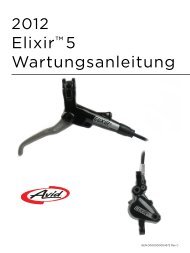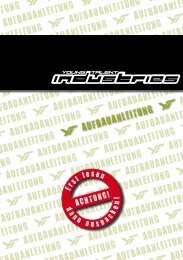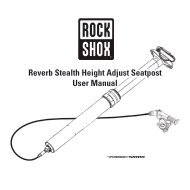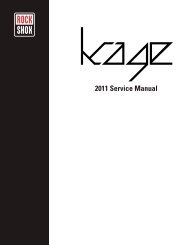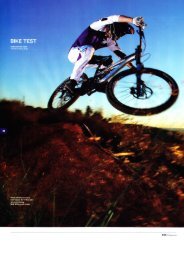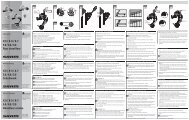AUFBAUANLEITUNG ASSEMBLY INSTRUCTIONS ... - YT Industries
AUFBAUANLEITUNG ASSEMBLY INSTRUCTIONS ... - YT Industries
AUFBAUANLEITUNG ASSEMBLY INSTRUCTIONS ... - YT Industries
You also want an ePaper? Increase the reach of your titles
YUMPU automatically turns print PDFs into web optimized ePapers that Google loves.
Adjusting the fork and shock<br />
The suspension elements we use allow for many<br />
adjustments. Please refer to the attached detailed<br />
instructions (Owners Manual) of the suspension<br />
manufacturer “Rockshox” or go to www.sram.com<br />
Basic adjustment<br />
The main criteria for the set up of the rear shock and fork<br />
are: - the weight of the rider<br />
„sag“<br />
and his position on the bike<br />
Sag refers to how much a suspension moves under just the<br />
static load of the rider. Sag is the first parameter for adjusting<br />
the suspention. At our bikes the sag should be between<br />
25 % and 35% of the total travel.<br />
TUES DH: 30-35 %<br />
TUES FR : 25-30 %<br />
You will find the suitable set up for your style by testing<br />
different settings.<br />
Please consider: each adjustment has an influence on the<br />
behavior of the bike – take care of yourself at the first test<br />
rides.<br />
Danger of crashing!<br />
Avoid all settings of suspension elements that will result in<br />
frequent snap-through. The parts will reward that with a<br />
long lifespan.<br />
In case of uncertainty we enjoin you to call upon the<br />
services of <strong>YT</strong> <strong>Industries</strong> or RockShox representative<br />
service@yt-industries.com<br />
Get to know your bike<br />
Familiarize yourself with your new bike! Make sure that all<br />
screws have been tightened with the correct torque, refer<br />
to the attached table.<br />
Our bikes come equipped with modern disc brakes with<br />
extraordinary braking power. The braking power increases<br />
after a short running-in period. Get used to the brake<br />
performance, testing it on different terrain. Position the<br />
brake lever and shifting lever “grip-compatible”, so that it<br />
can be pulled without cramping.<br />
Chose a easy, well-known terrain for your first test rides.<br />
Don’t forget: only practice makes perfect.<br />
Before using your bike each time<br />
Mountain bikes are naturally maxed out. Bike parts react<br />
quite differently under load, ranging from wear and tear<br />
to material fatigue. A sudden collapse of single parts<br />
may occur. Regularly check your bike for damage and<br />
periodically take it in for service.<br />
Prior to each ride you should check:<br />
The tight fit of wheels in frame and fork and the tight fit<br />
of your seat post<br />
The functioning of your wheels (free movement)<br />
The air pressure in your tires, the tension of the spokes<br />
and the slackness of the hub bearings<br />
The functioning of the brakes<br />
Signs of material fatigue (deformation, fractions, cracks,<br />
damage spots…)<br />
All other components regarding stability and reliability.<br />
The necessary tightening torque of all fittings<br />
Don’t ride if one of these deficiencies occurs.<br />
ATTENTION:<br />
During normal use of a mountainbike, vibration occur. This<br />
could leads to loose fittings. (even under use of thread -<br />
locking fluid.<br />
You had a crash<br />
Crashes are a strain on your bike and its parts. Before you<br />
carry on after a crash, always check your bike for damage<br />
and impaired functioning (also refer to “Before using your<br />
bike each time”).<br />
Don’t carry on riding if one of these deficiencies occurs.<br />
In case of uncertainty we enjoin you to call upon the<br />
services of <strong>YT</strong> <strong>Industries</strong> or a professional bike shop:<br />
info@yt-industries.com.<br />
Riding on public roads in germany<br />
The German traffic regulations (StVZO) stipulate the use<br />
of bicycles on public roads and paths with the following<br />
safety precautions: a brake and lighting system as well as<br />
a bike bell. Furthermore each cyclist is bound to maintain<br />
his/her vehicle in a roadworthy condition. We explicitly<br />
state that our bikes are not road-going (street legal)<br />
according to the German StVZO.<br />
14




